Whether you’re new to menstrual cups or are simply looking for some tips for the most comfortable fit, we’ve got you covered!
Learning how to insert a menstrual cup is easy once you’ve got the hang of it. Whether you're new to menstrual cups or you’re simply considering switching to one, we’ve got plenty of tips to help you feel at ease. Our aim is to make you feel comfortable and confident, no matter which period products you use.
We get it…you want to be more eco-friendly and do your bit for the planet, and if like us, you really like the idea of a reusable menstrual cup, but need some help getting it into position, you’ve come to the right place.
Menstrual cups are reusable small, bell shaped cups designed to collect period blood. Suitable for even the heaviest of flows, they sit a little bit lower in the vagina than tampons and can be worn for up to 8 hours. Lil-Lets menstrual cups are made from super-soft, flexible, medical-grade silicone, and are free from latex, BPA, and phthalates. And because we know life is busy, it even comes with its own certified cotton organic bag for convenience and storage.
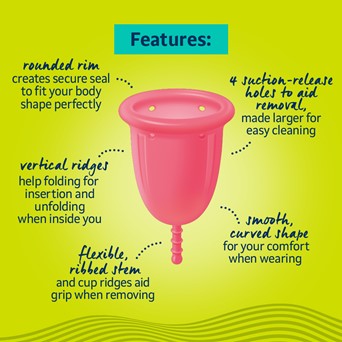
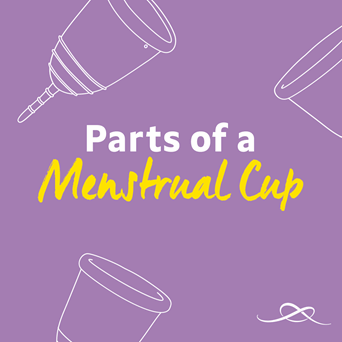
Like anything new, using a Lil-Lets menstrual cup can take a little getting used to, but trust us, with our tips you’ll be wondering what all the fuss was about.
Before you get started with a menstrual cup, you need to ensure you use the right menstrual cup size. Lil-Lets menstrual cups come in 2 sizes:
See the precise menstrual cup measurements in our handy menstrual cup size chart:

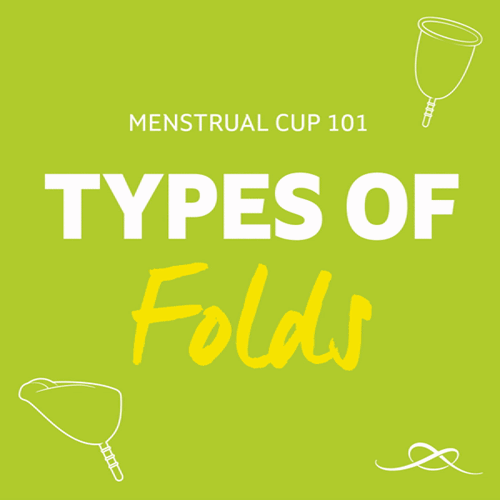
When it comes to folding your menstrual cup ready for insertion, it really is a case of finding what works for you. Here we list three of the most popular folds, but we know with practice and over time you will find the best technique that suits you.
View the folding techniques below.
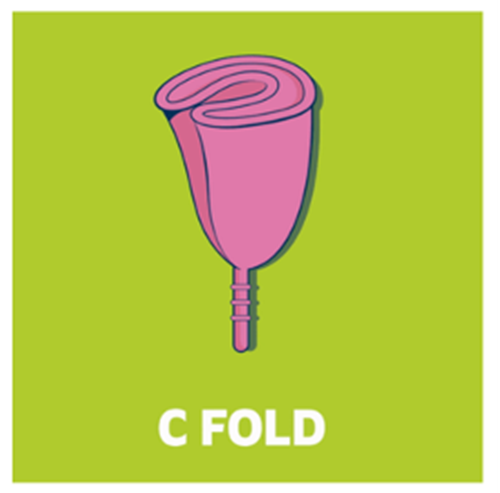
The clue’s in the title – this one makes your cup look like the letter ‘C’.
Step 1: Pinch your cup in the middle so it flattens.
Step 2: Now pinch the outsides together to make the ‘C’ shape.

This method requires a bit more thought than the ‘C’ Fold, but it’s just as popular.
Step 1: Holding the cup in one hand, use your index finger to push the rim of the cup all the way down to the base.
Step 2: Keeping your finger on the base, pinch the sides together to make a narrow opening at the top of the cup.
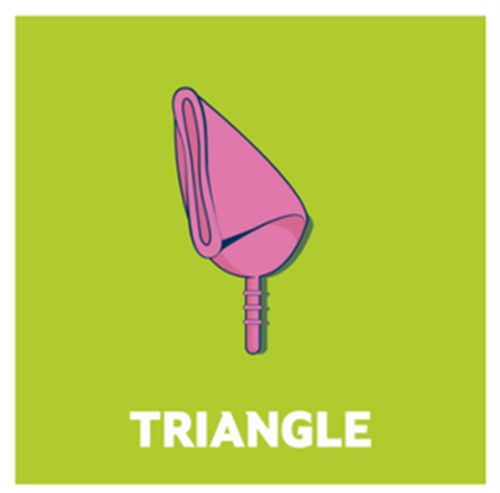
Don’t panic, this one sounds way more complicated than it is. You won’t have to fold the cup 7 times, we promise!
Step 1: Using both hands, pinch and flatten the cup.
Step 2: Take one corner and fold it to the base of the cup, making a triangle.
Or, if it’s easier, take that one corner and fold it halfway to the base, making a ‘7’ shape.
TOP TIP - This is our favourite technique for beginners as the triangle shape creates a smaller tip, making it easy to insert.
Now that you’ve tried the different folding techniques and sterilised your cup, it’s time to insert your menstrual cup. So, wash your hands and get into a comfortable position, maybe sitting on the toilet or standing with your knees bent. Relax, if you’re trying a cup for the first time, it’s a good idea to use it on your heavier flow days as this will help with insertion.
TOP TIP - Before using your menstrual cup, check that the 4 holes under the rim of the cup are well pierced. The little holes at the base of the cup play an important role in creating the seal that holds the cup in place, and breaking the seal when it’s time to remove it.

TOP TIP – If you’re still not sure if your cup is fully open, run your finger around the base of the cup, and if you feel any unopened sections, gently press right next to it until it pops.
Your menstrual cup should be emptied, cleaned, and reinserted every 4-8 hours, depending on your flow. To remove it safely, you'll need to break the vacuum seal that forms when the cup is in place. Don’t worry if this sounds tricky at first—it’s a simple technique, and with a little practice, you'll get the hang of it quickly.
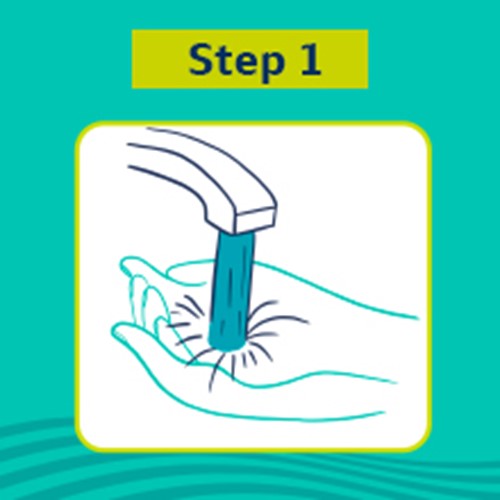
1. Wash your hands thoroughly and get into a comfortable position, such as squatting or sitting on the toilet.
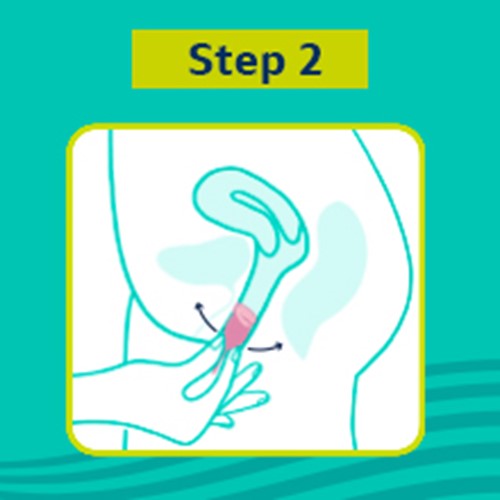
2. To release the seal, pinch the base of the cup to release the suction and give the cup a little ‘wiggle’ as you slowly lower the cup down.
TOP TIP – If you’re struggling to reach the base of your cup, give the flexible stem a gentle pull, whilst pushing down with your vaginal muscles until you can easily pinch the base of the cup.
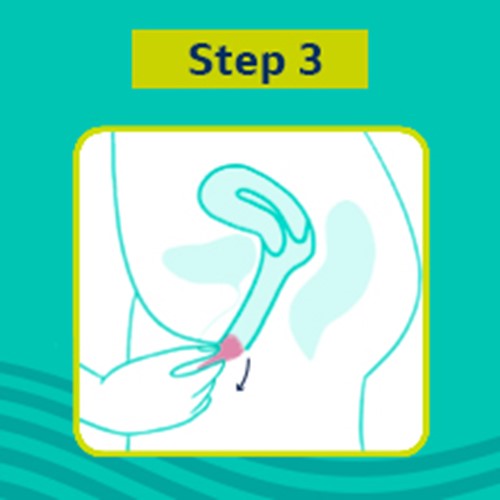
3. When you get near the opening of the vagina, carefully tilt the cup and remove one side of the rim first. Then, repeat and tilt the cup gently in the other direction. This is best method we’ve found for keeping all the menstrual fluid in the cup.

4. Wash your cup with cold water and mild soap, ensuring the suction holes are clear. Then you’re good to go, and can reinsert.
At the end of your period, you’ll need to sterilise your cup again, just like you did in the beginning and dry it thoroughly. Now pop it in your cotton storage bag. Store the bag in a cool and damp-free place until your next period. You see, it's not so difficult after all!
An important part of using a menstrual cup is cleaning it properly, so we’ve put together a quick step-by-step guide on exactly how to sterilise a menstrual cup so it is safe to use.
Always make sure your hands are clean before handling your menstrual cup. Using a gentle soap and warm water.
Wash the cup with warm water and mild soap, and then rinse thoroughly. You can squeeze the cup between your thumb and forefinger to dislodge any dried-up blood.
Immerse the cup fully in a pan of boiling water and boil it for 5 -7 minutes. This step sterilises the cup, ensuring it is bacteria-free before you insert it.
Allow the cup to cool in the pan and then remove it. Your cup is now ready for use.
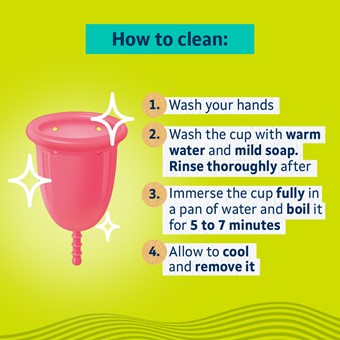
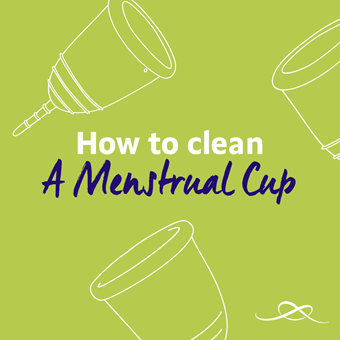
Menstrual cups can be worn up to 8 hours and are a reliable and efficient option for overnight protection. To ensure a comfortable night's sleep while using a menstrual cup, use the right size, empty it before you go to bed, and have backup protection on hand if necessary.
The simple answer is, anyone can get TSS, regardless of your age or gender and it can occur as a result of infections following burns, scalds, wounds, or surgery. Half of all TSS cases occur in people who menstruate and use internal period products such as tampons, menstrual cups, or diaphragms.
Generally, menstrual cups are very comfortable and once inserted, many users hardly notice they're on their period. But like anything new,, there is a bit of a learning curve, and some people may feel slight discomfort the first time they use one, and until they have more experience finding the most comfortable position.
No, the entire menstrual cup, including the stem, should be comfortably located within the vagina. If you find that the stem sits outside of your vagina, then it may need a little trim. Always trim the stem when not in use, using clean scissors and take off a little bit at a time, until you have the perfect fit.
With proper maintenance, a menstrual cup can last for several years. However, it’s advisable to replace your cup if you notice any cracks, splits, or tears, or if it develops a chalky residue or feels sticky to the touch.
If your menstrual cup is leaking in use, try not to worry, as frustrating as this is, generally a quick adjustment during insertion can usually solve the problem. It may also be that the cup has not formed a complete seal, and we always advise running a finger around the base of the cup one inserted to ensure it has fully opened out.
To clean and sanitise your menstrual cup, you can boil it in water for 5 minutes. Then, remove it and allow it to cool completely and dry. Alternatively, you can use a sterilising solution that is safe for menstrual cups.
Using a menstrual cup does not tear your hymen. Activities like sports, masturbation, and using a menstrual cup can all lead to gradual stretching of the hymen.
You may find wetting your cup with a little bit of water helps lubricate it, making insertion that little bit easier. But don’t be tempted to use petroleum jelly or other lubricants as they can reduce the longevity of your cup.
Yes, you can still use a menstrual cup, if you have an IUD fitted, although the use of tampons and cups is prohibited for the first 28 days following placement of an IUD. Remember too, that just like tampon, menstrual cups sit in the vagina, whereas IUDs are positioned inside the uterus. Our advice is to have a chat to your doctor or gynaecologist if you have any concerns about using a menstrual cup with this form of contraception.
Yes, and for those new to internal period protection we advise using the Lil-Lets Size 1 Menstrual Cup.
If you’re new to menstrual cups…and until you get the hang of using your cup, you may want to pop a liner in your underwear for back-up. But, we’re sure after a few uses, you will feel confident to go pad and liner free!
Like anything new, using a menstrual cup can take practice and we’re convinced that by your 3rd or 4th period you’ll be an expert at getting your cup into the most comfortable position. If this is still an issue, we suggest pushing the cup in a little farther so the only part sitting outside the vagina is the flexible stem. And remember aiming the cup in a slanting position towards the lower back is the best technique for insertion.